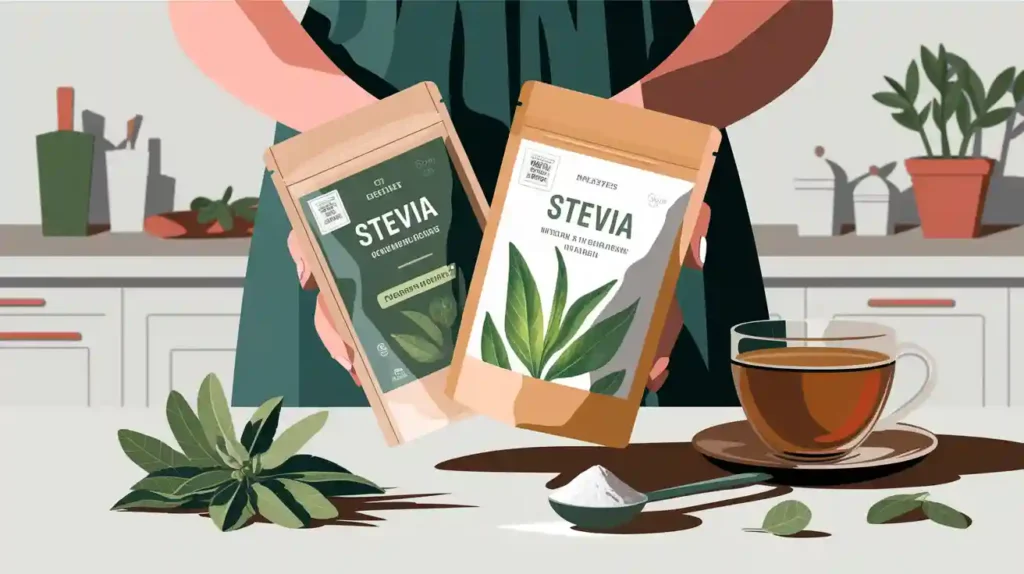
What happens when stevia loses its freshness before reaching the customer? Stevia must stay protected to deliver the best taste. Stevia packaging affects every batch. Custom Stevia Packaging can change how buyers see stevia. Stevia brands need packaging that keeps stevia safe, fresh, and appealing. Stevia deserves careful packaging choices.
Key Takeaways
Choose packaging that protects stevia from moisture, air, and light to keep it fresh and safe.
Use eco-friendly materials like kraft paper and cardboard to balance product safety with sustainability.
Design packaging that is easy to use, meets regulations, and connects with your target market to build trust and boost sales.
Choosing Stevia Packaging

Product Protection
Stevia is sensitive to its environment. Exposure to light and temperature changes can cause major product degradation. Scientific studies show that when stevia products, such as beverages, are stored at room temperature and exposed to light, they lose important compounds like anthocyanins and flavanones. Up to 95% of anthocyanins can degrade after 90 days in these conditions. Moisture loss and oxidation also damage stevia-based foods, making them dry and less stable. Proper stevia packaging shields the product from these threats, keeping it safe from moisture, air, and light.
Freshness and Shelf Life
Freshness is a top priority for stevia products. Oxygen and light barriers in packaging play a key role in preserving quality. Packaging materials with strong oxygen barriers prevent oxidation, which can cause rancid flavors. UV barriers protect stevia from photochemical damage. Kraft paper, for example, offers protection against oxygen, light, moisture, and heat. These features help maintain the aroma and taste of stevia, ensuring a longer shelf life.
Tip: Choose packaging with both oxygen and UV barriers to keep stevia fresh and flavorful.
Regulatory Needs
Stevia packaging must meet food safety regulations. Manufacturers need to use materials approved for food contact. Labels must include ingredient lists, nutritional facts, and allergen warnings. Tamper-evident features, such as seals or bands, help ensure product integrity and consumer trust. Regulatory compliance protects both the brand and the consumer.
Sustainability
Eco-friendly packaging is important for both the environment and brand image. Many companies now use recyclable or compostable materials. The table below compares common sustainable options:
Packaging Material | Environmental Benefit | Effectiveness for Stevia Preservation |
|---|---|---|
Cardboard | Recyclable, compostable | Provides sturdy outer protection, supports branding |
Kraft Paper | Biodegradable, compostable | Ideal for biodegradable packaging bags, eco-friendly option |
Corrugated Stock | Recyclable, compostable | Durable, reliable for packaging boxes |
Rigid Stock | Recyclable | Adds premium feel, good for branding but less eco-friendly |
Mylar Sachet | N/A | Protects against humidity, extends shelf life |
Polythene Bags | Limited eco-friendliness | Good moisture barrier but less sustainable |
High-barrier films, such as metalized BoPET, offer excellent protection but may not be as eco-friendly. Kraft paper and cardboard balance sustainability with product safety.
Cost and Efficiency
Large-scale stevia manufacturers look for cost-effective solutions. Automated packaging machines, like Vertical Form Fill Seal (VFFS) and Horizontal Form Fill Seal (HFFS), increase efficiency and reduce labor costs. These machines can fill and seal thousands of sachets per hour. Material choice also affects cost. Biodegradable sachets may cost more but appeal to eco-conscious buyers. Automation supports scalability and consistent quality.
High-speed machines save time and money.
Durable machines, especially those made from stainless steel, last longer.
Some machines print branding and nutrition facts directly on the package.
Consumer Convenience
Consumers value packaging that is easy to use and keeps stevia fresh. Pre-measured stick packs offer single-serve convenience and precise dosing. Moisture-resistant packaging prevents clumping. Compact designs fit easily into bags or pockets, supporting busy lifestyles. Tamper-evident and barcoded packaging builds trust. Resealable packaging extends freshness and reduces waste, which consumers appreciate.
Resealable pouches keep bulk stevia fresh.
81% of consumers prefer resealable packaging for its convenience.
Many are willing to pay more for resealable options.
Branding and Appeal
Packaging design influences how consumers view stevia brands. Bright images of berries or hot drinks make products look more appealing. Green backgrounds help shoppers quickly identify stevia products. Clear front-of-pack claims, such as “natural” or “no artificial sweeteners,” build trust. Larger pack sizes and single-serve packets attract different buyers. Retailers often place stevia near sugar or in special displays to boost sales.
Note: Packaging that highlights clean-label and sustainability claims appeals to health-conscious shoppers, especially younger consumers.
Stevia Packaging Materials
The choice of material depends on the form of stevia. Powdered stevia is usually packaged in sachets, which protect against moisture and air. Liquid stevia often comes in small, transparent plastic drop bottles for easy use. Edible films made from bacterial cellulose or alginate composites can enhance stability and add nutritional value. High-barrier laminates and metalized films offer strong protection for both powder and liquid forms.
Form | Common Packaging Type | Example Size |
|---|---|---|
Powder | Sachets, pouches | 1g, 40-pack |
Liquid | Plastic drop bottles | 10ml |
Closure Features
Effective closure systems keep stevia safe and fresh. Sealing systems, such as liners and linerless seals, prevent contamination. Tamper-evident features, like bands or breakable membranes, show if a package has been opened. Resealable closures, such as zip locks or pull tabs, allow consumers to use the product over time without losing freshness. Inspection systems check that seals are intact before products reach the shelf.
Closure Feature Category | Key Features and Benefits |
|---|---|
Sealing Systems | Liner and linerless sealing prevent contamination and maintain freshness. |
Tamper Evidence | Tamper bands, breakable membranes, and induction seals show package integrity. |
Liner Materials | Paper, foil, film, and pull tabs help maintain seal quality. |
Inspection Systems | Ensure closures are properly sealed and intact. |
Vacuum Closures | Maintain vacuum conditions, enhancing preservation. |
Stevia packaging that combines strong materials, effective closures, and appealing design helps brands deliver quality products that meet consumer needs.
Stevia Packaging Selection Steps
Assess Product Needs
Every stevia product has unique requirements. The form of stevia—powder or liquid—determines the best packaging approach. Powdered stevia needs protection from moisture and air. Liquid stevia requires leak-proof containers that prevent light exposure. Stevia leaves must be dried to a moisture content of about 10-13% for safe storage. This drying process reduces spoilage risk, but moisture sensitivity remains a concern. Packaging must provide a strong moisture barrier to keep the product stable and fresh. If moisture enters the package, stevia can degrade or even become contaminated by microbes. Companies should always match packaging features to the product’s sensitivity and shelf life needs.
Tip: Always check if the packaging can protect stevia from moisture, air, and light to maintain quality.
Know Your Market
Understanding the target market shapes packaging decisions. Consumer preferences for stevia vary by region and culture. North America and Europe lead the market because of high health awareness and demand for natural products. Asia Pacific shows rapid growth as more people seek healthier options and adopt new dietary habits. Latin America and the Middle East are emerging markets with rising consumer interest. Packaging must reflect these differences:
North America and Europe: Focus on eco-friendly, portable, and user-friendly designs.
Asia Pacific: Highlight convenience and modern appeal.
Latin America and Middle East: Emphasize education and clear labeling.
Companies use implicit-explicit testing to understand what consumers want. This method captures both automatic reactions and thoughtful opinions. It helps brands discover hidden motives and emotional responses. By using this approach, companies can design stevia packaging that connects with local consumers and stands out on the shelf.
Compare Materials
Material choice affects both product safety and environmental impact. Companies often select packaging based on recyclability, durability, and cost. Cardboard, kraft paper, and corrugated stock are popular because they are recyclable and compostable. Kraft paper is biodegradable and keeps stevia fresh. Cardstock and rigid stock offer durability and a premium feel. High-density polyethylene (HDPE) and polythene bags provide strong moisture barriers but are less eco-friendly. Life cycle assessments help companies choose materials that lower the environmental footprint.
Environmental Impact & Recyclability | Additional Benefits | |
|---|---|---|
Kraft Paper | Biodegradable, eco-friendly, recyclable | Keeps stevia fresh, cost-effective, sustainable |
Cardboard | Lightweight, sturdy, recyclable | Cost-effective, budget-friendly |
Paper-Based Materials | Eco-friendly, sustainable | Appeals to environmentally conscious consumers |
Recycled Paperboard | 100% recyclable | Provides clean surface for enhanced print finishes |
HDPE & Polythene Bags | Durable, moisture-resistant but less emphasized for recyclability | Protects from moisture, air, light |
Test Compatibility
Testing ensures that packaging works well with the stevia product. Companies must check if the packaging keeps stevia fresh and safe during storage and transport. For powdered stevia, sachets and pouches should prevent moisture and air from entering. For liquid stevia, bottles must not leak and should block light. Compatibility testing also includes checking if packaging fits with filling machines and labeling equipment. If packaging fails these tests, the product may spoil or lose quality before reaching the customer.
Note: Always test packaging with the actual stevia product and production equipment before full-scale launch.
Customize Design
Custom packaging helps brands stand out. Eye-catching graphics, unique shapes, and clear fonts make packaging memorable. Labels should include the brand name, product name, ingredients, nutrition facts, allergens, expiration date, and contact details. Brands can highlight benefits like low-calorie, gluten-free, or organic status. Consistent design across all channels builds trust and recognition. Companies often share their brand story on the package to connect emotionally with customers. Using eco-friendly materials also boosts brand reputation and meets consumer demand for sustainability.
Use creative graphics and logos for a strong brand image.
Keep design simple and easy to read.
Add a catchy slogan or brand story for emotional appeal.
Ensure all legal and safety information appears on the label.
Avoid Common Mistakes
Many companies make avoidable errors when choosing stevia packaging. Some select materials that do not protect against moisture, leading to spoilage. Others ignore regional preferences and miss out on market opportunities. Failing to test packaging with real products can result in leaks or damaged goods. Overlooking sustainability can harm brand reputation. Brands should avoid cluttered designs that confuse consumers. Regularly reviewing packaging performance and collecting feedback helps companies improve and avoid repeating mistakes.
Reminder: Match packaging to product type, market needs, and equipment compatibility to ensure success.
Stevia packaging decisions shape product quality and brand reputation. Companies should review current packaging and seek expert advice for improvements. Smart choices help stevia products stay fresh and appealing. Prioritizing packaging leads to better business results and stronger consumer trust.


